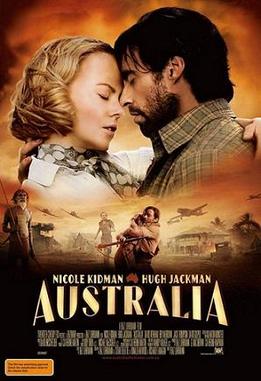Related Research Articles

Thunderbolt is a 1910 film in the genre of "outlaw" films at the time that tended to glorify the life of the outlaw "Bushrangers" that roamed the Australian outback in pre-commonwealth days. Shortly after this film was made, the government of New South Wales banned the manufacture of this type of film on the basis that they were promoting crime.

Leah Maree Purcell is an Aboriginal Australian stage and film actress, playwright, film director, and novelist. She made her film debut in 1999, appearing in Paul Fenech's Somewhere in the Darkness, which led to roles in films, such as Lantana (2001), Somersault (2004), The Proposition (2005) and Jindabyne (2006).

Smiley is a 1956 British-American comedy film directed by Anthony Kimmins and starring Colin Petersen. It was based on the 1945 novel of the same name by Moore Raymond who co-wrote the film with Kimmins. It tells the story of a young Australian boy who is determined to buy a bicycle for four pounds, and along the way he gets into many misadventures.

Australia is a 2008 epic adventure drama film directed by Baz Luhrmann and starring Nicole Kidman and Hugh Jackman. The screenplay was written by Luhrmann and screenwriter Stuart Beattie, with Ronald Harwood and Richard Flanagan. The film is a character story, set between 1939 and 1942 against a dramatised backdrop of events across northern Australia at the time, such as the bombing of Darwin during World War II.

John F. Gavin was a pioneer Australian film actor and director, one of the early filmmakers of the 1910s. He is best known for making films about bushrangers such as Captain Thunderbolt, Captain Moonlite, Ben Hall and Frank Gardiner. Known informally as 'Jack', Gavin worked in collaboration with his wife Agnes, who scripted many of his films.

Moonlite is a 1910 bushranger film about Captain Moonlite, played by John Gavin, who also directed. It was also known as Captain Moonlite and is considered a lost film.
Ben Hall and his Gang is a 1911 Australian film about the bushranger Ben Hall, played by John Gavin, who also directed. It is considered a lost film.
Agnes Gavin (1872–1947), was an Australian actor and screenwriter in the silent film era. She worked in collaboration with her husband John Gavin throughout her career. She wrote the majority of his films and was arguably the first specialist screenwriter in the history of the Australian film industry. In newspapers she was advertised as the "well known picture dramatizer" and was praised for creating "cleverly constructed stories". Many of her films are considered lost.
Frank Gardiner, the King of the Road is a 1911 Australian film about the bushranger Frank Gardiner, played by John Gavin, who also directed. It is considered a lost film.

The Assigned Servant is a 1911 Australian silent film about a convict who is transported to Van Diemen's Land. It was made by the husband-and-wife team of John and Agnes Gavin and is considered a lost film.
The Mark of the Lash is a 1911 Australian silent film. It is a convict-era melodrama made by the husband-and-wife team of John and Agnes Gavin.

The Martyrdom of Nurse Cavell is a 1916 Australian silent film about the execution of nurse Edith Cavell during World War I.
Keane of Kalgoorlie, or a Story of the Sydney Cup is a 1911 Australian silent film set in the racing and gambling circles of Sydney, based on a popular play by Edward William O'Sullivan and Arthur Wright, adapted from the novel by Wright.

His Convict Bride is a 1918 Australian silent film from the team of John and Agnes Gavin. It was a convict-era melodrama.
Assigned to his Wife is a 1911 Australian silent film from director John Gavin. It is a convict-era "military romantic melodrama".
Sentenced for Life is an Australian film directed by E. I. Cole. It was an adaptation of a play performed by Cole and his Bohemian Dramatic Company as early as 1904.

The Life Story of John Lee, or the Man They Could Not Hang is a 1912 Australian silent film based on a stage play about the true life story of John Babbacombe Lee.

Henry Albert ('Bert') Forsyth, known professionally as H. A. Forsyth, was a pioneer of Australian film production during the silent era. From about 1907 to 1909 Forsyth worked as a travelling picture showman, screening the film Robbery Under Arms in Australian country towns. In 1910 his company, Southern Cross Motion Pictures, produced and released two successful motion pictures, Thunderbolt and Moonlite, based on incidents in the careers of the bushrangers Frederick Ward and Andrew Scott. For these projects Forsyth worked with Jack Gavin, who directed both films and acted in the lead roles. In January 1913 the New South Wales Government banned Forsyth's bushranger films. At various stages in his career Bert Forsyth also managed theatres that screened motion pictures.
The Australian Photo-Play Company was a short-lived but highly productive Australian film production company which operated from 1911 to 1912.

Mates from the Murrumbidgee is a 1911 Australian silent movie. It is considered a lost film and was arguably the first Australian war film, being set during the Boer War.
References
- 1 2 3 "Advertising". The Referee . Sydney: National Library of Australia. 19 July 1911. p. 16. Retrieved 3 October 2013.
- ↑ Everyones, Everyones Ltd, 1920, retrieved 30 May 2018
- ↑ Andrew Pike and Ross Cooper, Australian Film 1900–1977: A Guide to Feature Film Production, Melbourne: Oxford University Press, 1998, 22.